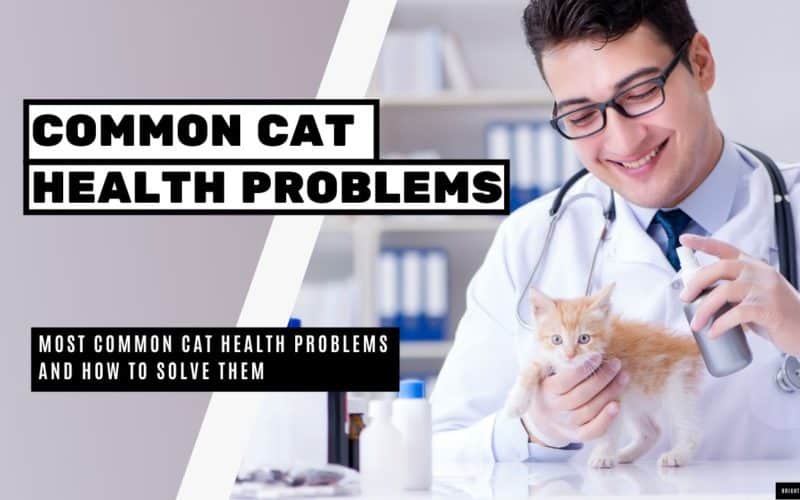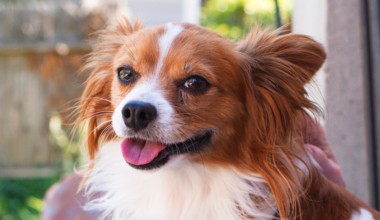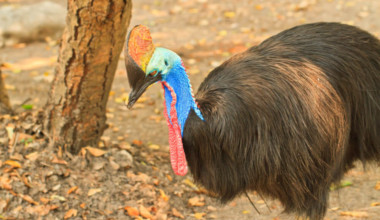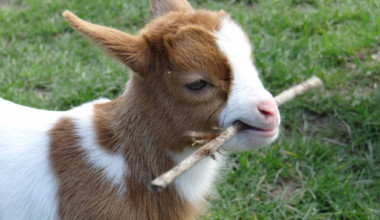Cat health problems are particularly common in breed cats. The constant breeding and genetic modification for preserving or intensifying their particular features, has led to many of these kittens suffering from health issues. But, besides breeds, other cat particular conditions may lead to compromised health.
That’s why if you own a breed cat, you need to get informed about the most common complications she may suffer and how you can solve them. Keep reading and find out what you can do to prevent these problems or what actions you may take to give your kitty a better quality of life.
Table of Contents
Common Cat Health Problems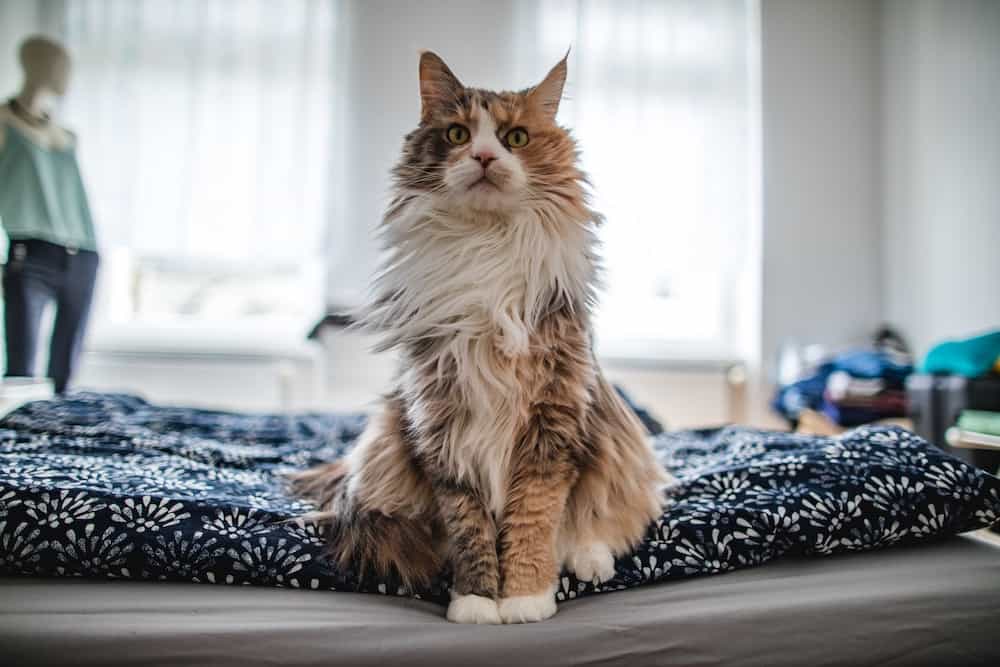
1. Urinary Tract Infections
Urinary Tract Infections (UTIs) is one of the common cat diseases most of the owner’s face (1). Cats have very small urethras, and because of this frequently end up with UTIs. Urinary Tract Infections can be very serious in cats, especially males, and it can be hard to detect a problem until it is very severe. UTIs left untreated can potentially become deadly if it spreads far enough.
Luckily, buying the right type of litter can help detect them early. Since UTIs change the PH of the cat’s urine, there are brands of litter that will change color if the cat gets an infection, helping you to get him to the vet long before the infection gets worse.
2. Vomiting
Ask any cat owner; felines are notorious vomiters. Cats throwing up undigested food is quite common and often harmless. Many times, it is simply a cat being a cat, but it can also be a significant health problem. Vomiting can be a sign of anything from eating a meal too quickly, to full organ failure. If your cat only vomits every once in a while, you can probably skip out on the vet trip.
If your cat is vomiting several times a day or has blood in the vomit then it is a sign of diseases, you’ll want to get your cat to the vet as quickly as possible.
3. Dental Disease
Most cats aren’t terribly pleased with their owners inspecting their mouths, and because of this, it is easy to miss the start of periodontal disease in cats. Dental disease is one of the most common cat health problems; however, and it can reach a very advanced state before the cat begins to show symptoms.
Regular screening at a vet and dental when necessary can protect your pet from harm and increase their lifespans.
4. Kidney problems
Cats are obligate carnivores, meaning that without a diet that contains meat in it, they will die. Unfortunately, their thirst reflex is not very strong due to the fact that their bodies are designed to get most of their nutrition from liquid-filled prey.
On a diet of dried food, kidney problems are a very real danger, since cats tend to be in a constant state of dehydration. You can help protect your cat from cat kidney illnesses by offering it canned food or getting the kibble wet, in order to help give them the hydration they need.
5. Fleas
Although fleas are not cat diseases, however, it has a high impact on cat health. Fleas and other parasites can also frequently plague cats, even indoor ones that never go outside. It’s very easy for a flea to hop on you while you are outside, and use you to hitch a ride straight to your cat.
If you spy your dog scratching, notice “dirt” on your cat, or see live bugs crawling, treat the cat and the house immediately. 30-day flea treatments and bombing your home are good steps to get rid of the problem quickly.
6. Heartworm
Heartworm is only prevalent in specific areas, but they are a deadly concern for those who live in heartworm areas. Cats should be regularly screened for heartworm, and if you live in an area where they live, keeping the dog on heartworm prevention is essential to your cat’s well being.
Once a cat has heartworm illnesses, it can be very difficult to treat and can be fatal. If you’re not sure whether or not you live in a heartworm area, ask your local vet.
7. Obesity
Sure, a fat cat can be pretty cute, but it can cause a lot of health problems in your pet. If your cat is a little heavier than it should be, you can help through getting your cat more active and cutting down on food.
Since cats can’t always be walked on a leash, you can still improve their activity by spreading their food out, so they need to travel around the house to get it, or playing with them.
Fat cats can suffer from a variety of different diseases, including diabetes and heart disease, which are potentially deadly. Keeping your cat slim will increase its lifespan, and make those years more enjoyable for you both.
8. Cancer
Cancer is one of the most common cat diseases older cats face. Thanks to good vet care, more pets are living longer, and the longer they live, the more likely it is they will eventually face cancer. It’s extremely important to catch cancer early to give your cat the best chance at a positive outcome, and that means getting the cat checked regularly by a vet as they age.
9. Upper Respiratory Infections
Cats have surprisingly delicate lungs, and one of the problems they frequently face is an upper respiratory infection. Typical signs are sniffling, sneezing, discharge, a change of attitude, and appetite. If you see these signs, get your cat checked by a vet, as a bad infection can potentially be deadly.
Cats that live with other cats, including multiple cat households, are the most likely to come down with an upper respiratory infection. If your cat has the sniffles, take it seriously, and visit the vet for treatment as soon as possible.
10. Feline Leukemia
Feline leukemia is the second most common cause of death in cats, second only to physical injury, such as getting hit by a car. Cat feline leukemia is contagious, and while most cats who encounter the disease can fight it off, those who can’t have a much less happy outcome. Outdoor cats are far more likely to encounter the disease than indoor cats, so for safety, keeping your cat inside may be best.
Cats make excellent pets, and wanting to keep them healthy is a natural part of being a pet owner. If you’re concerned about your pet’s health, paying attention to these ten common cat health problems can potentially save your pet’s life.
Overweight Cat Health Problems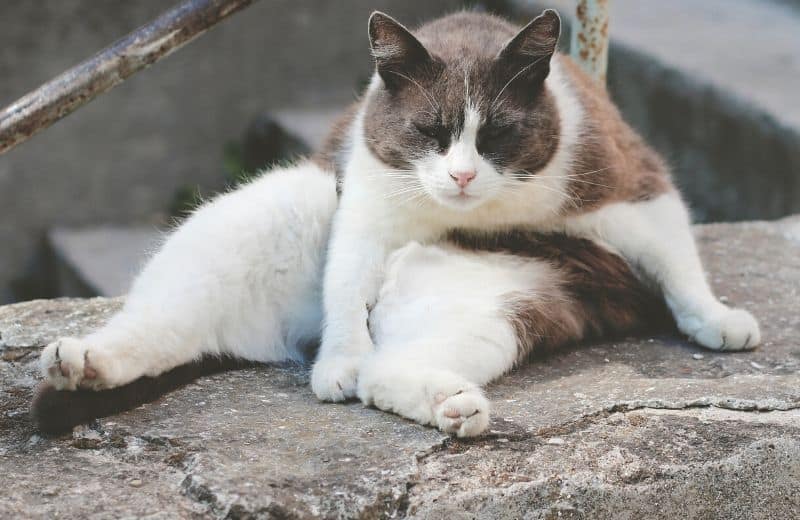
Cats with this condition can become sick animals (2). For example, weight gain often raises blood pressure. Many kittens go blind because of this. In some cases, blindness can occur in only one eye.
Puss living in this state of health, breathe hard and tend to be constipated. They may have trouble cleaning themselves.
An overweight cat is also more likely to have fur problems. Our kitties can develop dryness or even acne. They may also have more sensitive skin, which is easily irritated.
We must also be attentive to their mental health. Puss with this problem of weight have difficulty reacting quickly to possible threats. Some cats stop running when they feel in danger. This behavior, contrary to their instincts, causes them a lot of stress. Furthermore, even if our fluffy friend does not develop any disease for overweight, it significantly reduces our four-paws pal’s life expectancy.
If you don’t pay attention to your cat’s overweight on time, he will be obese. Then dangerous diseases like diabetes or kidney problems start to appear. Most overweight-related illnesses usually come on suddenly, and owners often find out when the situation has already come a long way in medical terms.
Prevention is the key to avoid all the problems related to being overweight. Sometimes, with age, some cats tend to accumulate a little weight. But if you notice that your cat’s girth or waist begins to fade and begins to become a rounder figure, then chances are good that you have an overweight cat.
The best thing you can do is to consult the vet. He can make sure if your cat is overweight. In this way, you can prevent your beloved pet from running any health risk.
Obese Cat Health Problems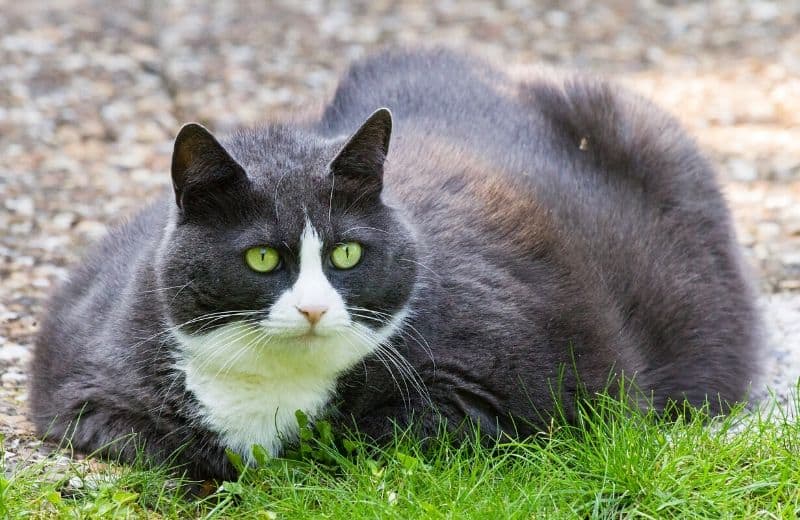
A fat cat does not mean that it is a sick cat. However, an obese cat is indeed a cat at risk of disease. From diseases like skin problems to critical ones like pancreatic problems or even cancer, serious cat health problems can derive from obesity.
The most frequent ones are diabetes, hypertension, and heart difficulties. Other difficulties related to obesity in cats are arthritis and problems associated with bladder or urinary tract.
1. Diabetes
Diabetes is one of the most frequent cat health problems (3). Many obese kittens need a daily dose of insulin. The good news is that diabetes can recede if the cat loses weight. Diabetes occurs when the cat accumulates excess fat, causing its body to fail. The cat’s body cannot regulate glucose as before, causing hypoglycemia in many cases.
The main symptoms of diabetes in cats are:
- bad breath
- urinary tract infections
- dehydration
- weakness
- vomiting
- and inflammation.
2. Feline lower Urinary Tract Disease
This name or the FLUD abbreviation is the term currently used to describe all Urinary tract infections in cats, which can be severe. When suffering from FLUD, the cat begins to drink less water, facilitating the formation of stones in the kidneys.
Obesity can also cause cystitis. Inflammation occurs in the bladder that is mostly known as Feline idiopathic cystitis. Currently, in severe cases, no cure is known. Medication is the only way to control this condition, and cat habits must be changed.
The best way to realize that your cat has this disease is if you notice an unusual change in his way of urinating. But the most common symptoms are:
- urinating more than usual
- meowing from painful urination
- frequent small amounts of urine.
- Sometimes there can be blood in the urine
- constant licking of his genitals
- urination in inappropriate places such as in the sink.
If you notice that your cat does not pee at all, it may have a blocked bladder. In that case, you should immediately go to a veterinarian, preferably in an emergency. Your cat will probably need a medical intervention right away.
3. Arthritis
Arthritis is also quite common. This problem causes severe pain in our fluffy friend and can affect any joint. For this reason, cats begin to move with great difficulty, and most of the time, they feel uncomfortable. Puss suffers from pain every time it makes a move.
A feline with arthritis sleeps more than usual and has difficulty getting on and off places that are not necessarily high. Cat’s shoulders will be a little more prominent. He will lick himself excessively.
The kitty will tend to show a generally negative mood, will be down, upset, or bitter. He will not bear to be touched or caressed as before. Learn about cat’s arthritis and pain relief here.
4. Liver disease
Another common cat health problem in obese cats is liver disease. The liver is the organ that is directly related to the storage of fat in the body. 90% of cats with obesity suffer from this disease.
Find out more about how this disease relates to obese cats, here!
5. Spine mobility
One of the less common problems, but that seriously affects the cat with obesity is immobility of the spine. Felines with this problem move with difficulty and some cannot mobilize at all. This problem happens due to the accumulation of fat between the vertebrae.
6. Other complications
Furthermore, obese cats have a tendency to reduce the level of tolerance to anesthesia, which complicates their situation in surgical procedures.
They can also develop various respiratory problems, especially asthma, which is usually very uncomfortable for them and seriously complicates their lives.
When there is obesity, the immune system of felines is compromised. Because of that, it is not uncommon for felines with obesity to suffer from infections.
If you want to prevent your pet from developing any of these cat health problems, it is best to make him lose weight with a low-calorie diet. Find more information on how to help your obese cat, here.
Diet is not the only cause of obesity. One of the most likely causes of obesity in cats is lack of exercise. Cats with obesity tend to be less active, the lack of activity aggravates the diseases, so this problem becomes a dangerous cycle.
Therefore, make sure that your cat has enough physical activity, and if you’re not sure how to do it, click here.
Older Cat Health Problems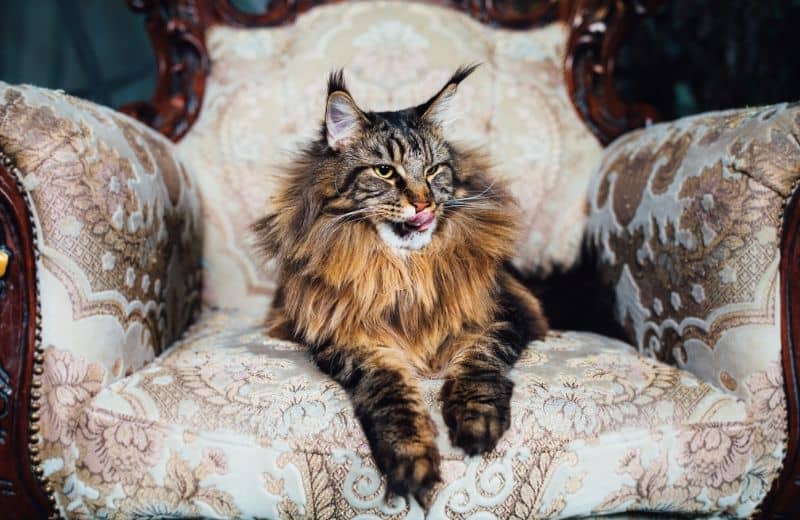
You can consider a cat to be old if it is over eleven years old. From then on, the risk of experiencing severe illnesses increases dramatically, as does the possibility of dangerous mishaps such as choking on food.
1. Cognitive problems
Older cats have cognitive problems. Among the most common, we can identify problems with orientation, changes in the meow, and the tendency to isolate. It is striking as we get older, many of our furry friends begin to sleep or rest in places that they were not used to before.
Advanced age makes our pets less stress-tolerant. Other conditions related to aging are changes in the sense of smell and taste. The reduction in its flexibility skills is more evident. When this happens, the ability to clean up becomes difficult. Therefore they have more difficulty feeling relaxed and comfortable (4).
2. Change in Modes
There is also a very noticeable change in the way they interact with their environment. When there is a health problem, old cats change their modes of social interaction. They can also become more insecure about themselves. They start hunting less, going out less, and playing less.
For this reason, they begin to depend more on their owners, so they try to always be by their side (5). These symptoms can be related to pain.
Older cats can also get hurt more easily by missing a simple jump or breaking a bone with a fall. In older cats, this may be a symptom of some cognitive difficulties.
3. Probability of higher health problems
As time passes, the probability of health problems is higher. They can suffer from diseases such as intestinal problems, diabetes, thyroid problems, and kidney illness.
Heart disorder is also a particularly common older cat health problem. The consequences of these problems can be heart failure, hypertension, arrhythmias, or heart attack. It affects them principally due to the degeneration of the valves. Many older cats suffer from heart muscle related to a heart condition.
Some people may think that old cats suffer from vomiting since it is a problem that can become common suddenly, especially in the last times of the cat’s life. The truth is that vomiting is one of the symptoms of a kidney malfunction. So the cat may already be sick with kidney disease.
Sometimes a chronic vomiting problem can appear (6). The reason may be hairballs. For old cats, expelling fur balls becomes increasingly difficult, causing digestion problems. Hairballs can also cause constipation. Many times this can be solved with vitamin supplements, but it is best to have a vet examine our pet.
4. Other complications
Other health problems that can appear with age are loss of appetite and incontinence. There is also dementia, memory problems, deafness, dental problems, and gas or flatulence problems.
Cancer is also usually a disease closely related to old age. In many cases, this causes them great depression. Cats with cancer suffer a lot of pain, so they meow very often or change their way of meowing.
The most common kind of cancer is gastrointestinal. Its symptoms include diarrhea, vomiting, and weight loss. You should be aware of any lumps or bump that you feel in your cat’s body. If you find anything unusual, don’t hesitate to call a vet!
It is essential that when our ball of fur is old, we keep a regular checkup of his health, to help make his old age as comfortable as possible (7).
Munchkin Cat Health Problems
Munchkin kittens are just as adorable as the name sounds. These tiny felines are actually the result of a genetic mutation or dwarfism that can come up naturally from birth and results in shortened limbs.
These cats are actually quite healthy and have a long lifespan of around12-15 years. But the issue is that, as mentioned, many clubs are breeding these cats with each other, accentuating the feature and developing some cat health problems.
Many problems haven’t been proven yet, as the breed is relatively new, with less than 20 years and not being accepted as an official breed yet. Actually, other than a high death-rate when both parents are Munchkin, these kittens don’t seem to suffer from any congenital problems. However, their spine and bones may be vulnerable to certain conditions or limb deformities (8).
Among the most common Munchkin cat health problems we can find:
1. Lordosis
Lordosis is a spine condition that shortens the spine muscles, preventing them from fully developing and resulting in slight spine curvature. While this condition is not specific to Munchkin cats, the breed may be more vulnerable due to the disproportion between the spine length and the legs.
In cats with moderate lordosis, no actual health issues may arise. If the condition is severe, on the other hand, the kittens may suffer from intense pain, paralysis, and even death.
Once again, this may happen to all cats. In case your Munchkin suffers from this cat health problem, you may help him have a better life. Make sure to provide him with steps to get to high places, or accommodating the space, so she doesn’t need to jump or climb much.
2. Pectus Excavatum
Common in both Bengals and Munchkins, this condition consists of an overdeveloped chest bone. While it may make kittens look funny and have a tortoise-like neck, the truth is that it doesn’t affect cats’ general lifespan or quality of life.
3. Deprived jump
So, this is simple logic, any creature with shorter legs will jump less than another being with longer legs. Period. That being said, Munchkins seem to not be as fond of jumping as regular cats are. Some vets and animal rights activists claim that this may respond to an intense joint pain they feel due o their limb deformity.
However, there’re no studies yet that prove this theory. On the other hand, many owners and breeders claim that the kittens are actually quite capable of jumping.
4. Urinary problems
Probably the only real cat health problem associated with short-legged cats is a slightly higher predisposition to suffering from urinary problems. According to a Japanese study, as the urinary tract is closer to the ground than in any other species, the Munchkin kittens may collect bacteria easier.
Making sure that your kitten is clean, keeping her indoors as much as possible, and regularly visiting the vet is more than enough for keeping her healthy. In case you notice that your kitten is in pain when peeing, it leaks, or the pee is too dark or with blood, go immediately to the vet!
Scottish Fold munchkin problem
While pureblood Munchkins are quite healthy, breeding them with Scottish Fold kittens may result is severe cat health problems. These issues may not even have a solution, and euthanasia may be required, and promoting this breeding is cruel.
To learn more about this, click here!
Calico Cat Health Problems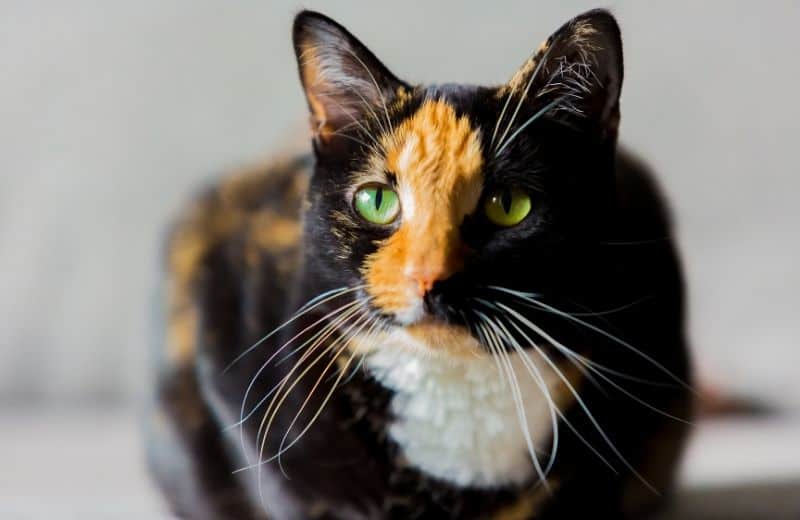
Have you ever heard about the Maneki-Neko or Beckoning Cat, this cute Japanese figure of a three-color cat saluting? Well, that’s what a Calico is, exactly. Unlike many people think, Calicos are not a specific breed. Instead, the name refers to the color on their fur.
These cats are rare and sometimes confused with tortoiseshells. Calicos are known for having a white base of color with black, grey, and orange spots.
Calicos are mostly females, as the black and orange colors come from the X chromosome (keeping in mind that mammal female’s chromosomes are XX) (9). White comes from suppression of color in both females and males.
The thing is that the X chromosome is also responsible for producing a vital protein. In this sense, the females with heir XX chromosomes would have serious health problems if they wouldn’t compensate for those extra proteins. So, they use the protein with the color gene to produce the orange and white patches, while the black may come from the father’s chromosome.
Female Calicos are as healthy as any other cat could be, but males, on the other side, are not as lucky.
Male Calicos are extremely rare (10). As mentioned, the Calico condition happens due to the duplication of the X chromosome, which determines whether the color is black or orange. In this sense, as male cats’ chromosomes are XY, they can only be either orange or black (in combination with white).
So, how are Calico males possible? Precisely due to a cat health issue called Klinefelter Syndrome (11). This syndrome consists of a mutation of the chromosome pair, resulting in d double X chromosome alongside the male Y chromosome (XXY).
This syndrome allows the male cat to present both orange and black colors alongside the white coat. On the other hand, the condition strongly impacts the testicular development, resulting in sterile specimens.
Only 1 in 3,000 calico cats are males, and most of them may live a regular life as any sterile male cat. However, Klinefelter may also impact bones and muscles in some cases, making the kitten suffer from pain and paralysis.
Only 1 in 10,000 calico cats are male and fertile, and this infertility responds to a condition called chimerism, where the cat has two chromosome chains XX/XY (12). This condition hasn’t been studied enough but, as long as it’s been known, it hasn’t represented a threat to the Calico cat’s health.
Tortoiseshell Cat Health Problems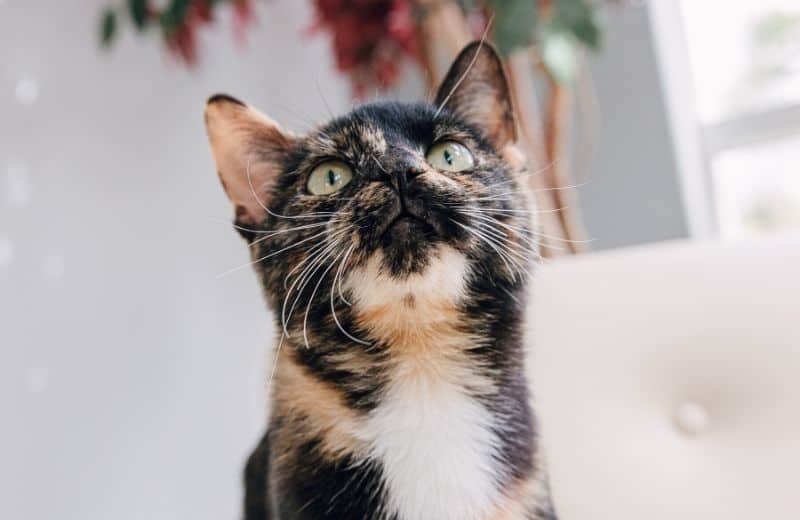
Tortoiseshell cats are a particular type of Calico cat. Unlike regular Calicos, that have defined black, orange, and white spots, Tortoiseshells have little to no white spots on them. This pigmentation responds to Calicos having a color suppressant gene while Tortoiseshells don’t.
As they’re indeed Calicos, the only health issue related to Tortoiseshell is Klinefelter Syndrome and the consequent sterility. Of course, as they can come in several breeds, you should always keep an eye on regular cat health problems such as kidney malfunction.
Ragdoll Cat Health Problems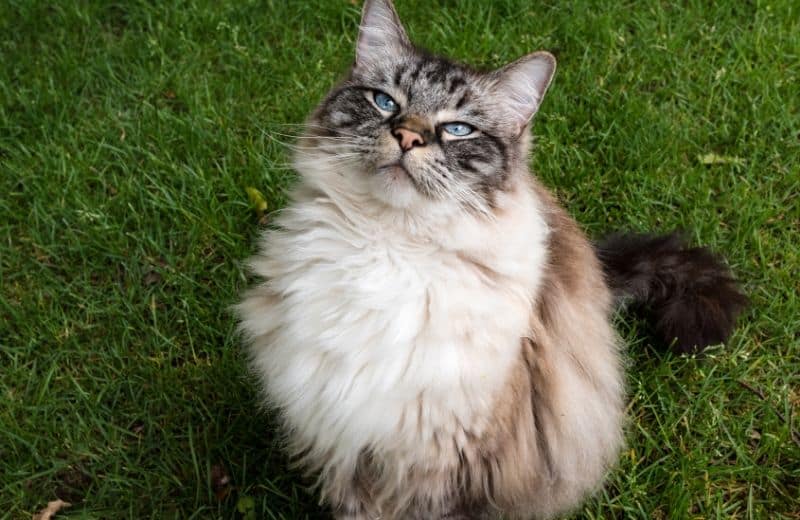
Ragdolls are one of the favorite housecat breeds in the world. They are fluffy and highly friendly. They are so affectionate that some Britain breeders are trying to make the genetically less approachable, so they don’t get robbed or hurt by aggressive animals.
This breed is one of the most affected by unconscious inbreeding, resulting in all kinds of health problems in the litters. Their death-rates are considerably high, and many kittens are born with deformities or a weak immune system. Besides that problem, Ragdolls are also highly related to the following cat health issues:
Obesity
As these cats are fond of being held and laying around, they also tend to become quite sedentary. Of course, these cats are ideal for grannies and disabled people that can’t move much. However, it’s recommendable that you take good care of their food, as their lack of exercise can quickly develop in obesity. Another essential factor to help them prevent obesity is by stimulating their curiosity with toys and games, so they move a bit more.
Urinary infections and further kidney disease
One of the most common cat health problems in ragdolls is urinary tract infections. This condition is related to cats, but commonly seen in this breed, which leads to kidney disease.
The urinary infections may be regular tract infections or a specific cat disease known as feline lower urinary tract disease (13). These infections start with the following symptoms:
- Constant and difficult urination.
- Stiffness and uncomfortable body mobility when urinating.
- Pain and cry when urinating.
- Bloody urinate.
- Leaking
All these symptoms can relate to the previously mentioned diseases and, if not attended in time, may lead to polycystic kidney disease (14).
This disease results in the progressive malfunction of the kidney and is not reversible. However, flushing the kidneys and having a proper diet may prove enough to provide your ragdoll a high quality of life.
Castrating your kittens is also a highly recommended preventive measure for any kidney-related disease.
Feline asthma
Cats are as likely to suffer from allergies and asthma as humans. Actually, there’s a particular type of asthma called feline asthma and is quite common in ragdolls (15). The symptoms are:
- Constant wheezing
- Coughing
- Leaking nose
It’s essential to attend this issue as soon as spotted for avoiding the lungs from swelling and developing further and incurable respiratory conditions.
Digestive complications
While curiosity in cats makes them prone to digestive issues due to eating things they shouldn’t, ragdolls – and any long-hair breed – has a particular vulnerability to these issues.
Especially when not well-groomed, ragdolls tend to swallow too much hair. If they don’t manage to expel it quickly, you’ll see symptoms like:
- Vomiting
- Diarrhea
- Gagging with or without expulsing anything
- Apathy and general unease.
An excellent solution to solve this cat health problem is by brushing them often. In case your cat already presents these symptoms, using malt paste is an easy and safe way to help them out.
Hypertrophic CardioMyopathy (heart disease)
Alongside the Maine Coons, the ragdolls are particularly vulnerable to developing Hypertrophic CardioMyopathy condition which overdevelops the heart wall (16). This happens because of a genetic defect common in these breeds that make 30-40% of specimens suffer from this disease.
While HCM is not necessarily lethal, and many cats may live a relatively standard life, it may also lead to heart failure and death. If you’re a Ragdoll owner, it’s recommendable to ask your vet to check if the cat’s heart is pumping accordingly.
Tonkinese Cat Health Problems
Tonkinese is a relatively healthy breed, with only a few issues to highlight. These kittens are known as the hypoallergenic cat, as their hair is considerably short. Even so, allergy to cats comes from a protein in their saliva, which implies that short-haired cats are not hypoallergenic, just hold less saliva in their hair.
Tonkinese cats a mix from Siamese and Burmese and, unlike their parents, their health issues are reduced to:
Diabetes
While the breed is not highly related to the disease, as it’s bred from Burmese (which suffer consistently from this disease), they present a vulnerability in front of other crossed cats.
Hyperthyroidism
While first Tonkinese generations were highly related to benign tumors on the thyroid that generated hyperthyroidism, a 2017 study by the Journal of Veterinary Internal Medicine confirmed a decreased vulnerability in this breed (17).
Besides these diseases, Tonkinese is mildly vulnerable to common cat health problems such as:
- Hypertrophic CardioMyopathy
- Cat asthma
- Gum disease
Bengal Cat Health Problems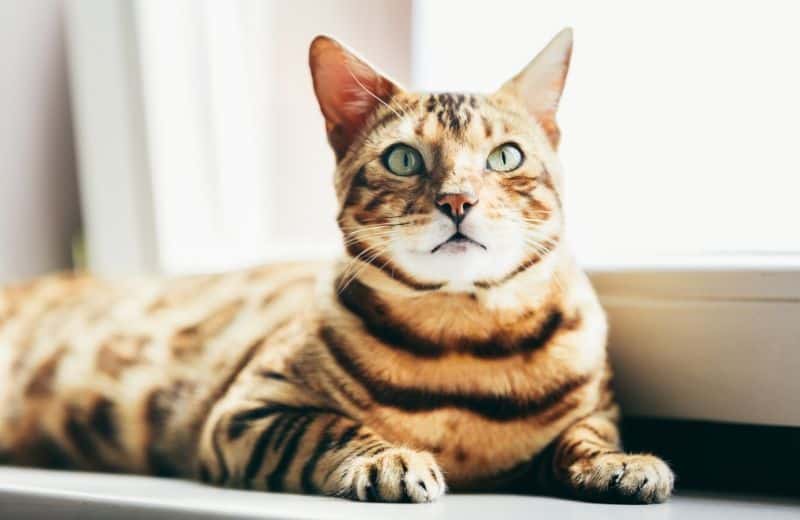
Bengal cats are one of the most popular as their patterns make them look wild and exotic. However, as they’re a pure pedigree breed, they have some disposition to particular cat health problems.
In this case, the eyes seem to be the most affected, as there’s more than one ocular condition that these kitties may inherit or develop.
Entropion
One of the most painful and uncomfortable diseases a Bengal may suffer in its eyes is entropion. It consists of inverted eyelids due to the eyeball rotating to the opposite direction of the cornea.
It’s most common in the superior eyelid, but it can affect both and cause intense swelling. Your cat may scratch the eyes, attempting to fight the discomfort, making it even worst.
The only solution to this condition is surgery. Among the symptoms, you may find:
- Constant blinking
- Swelling of eyelids
- Scratching and rubbing the eyes consistently.
- Disproportionate mucus production from the eyes.
To find out more symptoms and the causes of this annoying cat health issue, click here!
Conjunctivitis
With considerable delicate eyes and an active personality, Bengals are more prone to have an eye infection or scratching, resulting in common conjunctivitis. This issue can also occur due to allergies or dry-eye, which may be treated by simply adding some teardrops.
However, depending on the severity and the cause, the kitten may need some antibiotics to finally beat the infection.
Cataracts
A cat health problem commonly inherited in this breed, cataracts may eventually leave your cat blind due to an opaque eye-lens (18). You’ll notice because the eye will present a grey spot that will progressively grow until the whole eye is grey (19).
While they may be cured with a simple surgery, it doesn’t always work. If your cat develops it in only one eye, it may have an almost regular life without surgery.e
Progressive Retinal Atrophy (PRA)
As any inbreed breed, Bengals suffer from inherited cat health problems, and PRA is one of the most common in this breed (20). It consists of the receptor of light in the back of the eye progressively degrading, until they can no longer capture it at all, and the cat gets blind.
While there is not an exact way to know if all of a sudden, your cat becomes more vocal and finds it hard to detach from you, it may be a sign of it getting blind, pay attention (21).
A practical tool for Bengal owners to prevent this disease is by feeding enough Taurine to their pets. Studies demonstrate that PRA may be related to low amounts of this component.
Bengal nose
A poor diet or an allergy issue may develop what is known as Bengal nose or nasal hyperkeratosis. Relatively recently discovered, this disease may lead to ulcers or crusting.
While it’s believed that the disease passes from parents to kittens, the true nature of the Bengal nose is still unknown. Many organizations, such as the Genetic Institute of Bern, Switzerland, are currently studying the condition.
If you’re a Bengal owner, you may join the studies by sending your blood samples here!
Russian Blue Cat Health Problems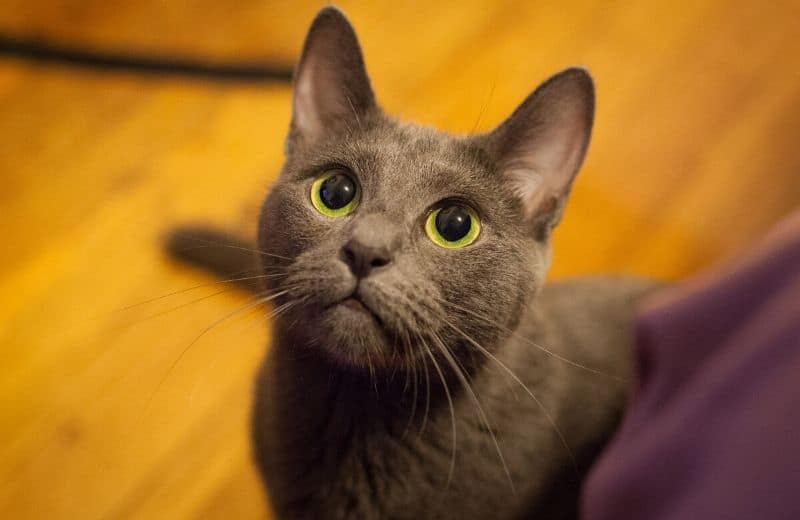
Once again, we see the consequences of perpetuating a breed by selecting breeding and genetic modification. Russian Blue cats, as well as Bengal cats, suffer their destiny of being pedigree cats. Here are some of the most common cat health problems that can affect your Russian blue cat:
1. Genetic predisposition to diseases
Russian Blue cats have been considered by a lot of veterinary specialists as an extraordinarily healthy specimen, compared to other breeds. But as we mentioned, some cats that were the product of inbred crosses are more susceptible to suffer congenital hereditary anomalies like the followed ones (22):
2. Heart diseases
Feline hypertrophic cardiomyopathy is also common in Russian Blues. It causes thickening of the myocardial walls, specify in the left ventricle of the heart, and reduces the volume of blood pumped by the heart. Also, this heart deficiency has been considered an inherited disease and commonly appearing in older cats and mostly males.
These diseases can be present without any symptoms but, here we will show you some of them:
- Inactivity
- Depression
- Difficulty breathing
- loss of appetite
- Torpid
3. Genetic mutations
Another anomaly related to inbred reproduction is polydactyly. There’s not considered as diseases properly. The extra toe is a very uncommon condition.
If the mutation appears with other conditions called radial hypoplasia (extra tiny twisted toes), the disease could affect your cat´s walk and its legs’ health.
This breed is more susceptible to several infections and parasites diseases. However, a lot of these diseases and their impact can be reduced or avoided if you keep track of your kitten vaccinations. Here we will show you the most representative:
- Cat flu
This infection is caused by two different viruses. They are called feline herpesvirus and feline calicivirus. Also, the impact of the disease is severe and sometimes deadly.
It is a very contagious disease; it mostly affects younger, older, non-vaccine cats, and the ones with a depressed immune system. Some of the symptoms are sneezing, coughing, difficulty breathing, eye ulcers, mouth ulcers, loss of appetite, and fever.
- Feline immunodeficiency Virus
This is one of the slowest acting cat diseases because most of the infected cats don’t present any symptoms in the initial years of infection. The FIV makes the cat more susceptible to other infections, making them more dangerous to them than not infected cats.
The disease can be transmitted by a pretty deep bite, and this sort of violent wound is expressly part of the world of outdoor cats. Usually, they have aggressive fights for territory, making them vulnerable to catch it.
This cat health problem doesn’t have a cure, but your cat can have a long life with it. Changing their lifestyle is the key; some of the things you can do for it is:
- Keep your cat inside the house, make him an indoor cat.
- Avoid raw food.
- Use immune stimulations agents.
- Vet control.
- Vaccination and parasite control
Other diseases that affect your Russian Blue cat are:
4. FLUTD
Already mentioned several times, feline lower urinary tract disease is the presence of one or more variety of conditions that affects the urethra and bladder of our cat. It can be caused by urinary calculi, tract infections, or obstructions.
Some of the symptoms are:
- Meowing during urination.
- Foul-smelling urine
- Frequent licking in the genital area
- Urinating in different places
- Presence of blood in the urine
To choose the treatment for the diseases is necessary to do a lot of things first, but most of what is causing it in the first place. Also, the vet has to determine the changes that can present in the urine, clinical signs, presence of any obstruction, and others.
To prevent our cat to suffer is necessary to visit your vet for regular checking. Also, adjust their diet, and to reduce their stress because it can affect a lot to the symptoms, making them more painful for them.
5. Weight problems
This breed is known for its big appetite, and something relevant to care about is their nutritional behavior. When the owner controls this part of their life, they are also preventing a lot of conditions related to weight that may generate cat health problems.
There’s essential to establish a daily amount of food that makes it satisfied and also is healthy for them.
If you want to take care of their shape and weight, you must do the following things:
- Choose a very nutritional food that has all the vitamins that it needs.
- Follow the quantities’ instructions of your vet or the ones that are in the package.
- Make sure that your cat exercise.
Hermaphrodite Cat Health Problems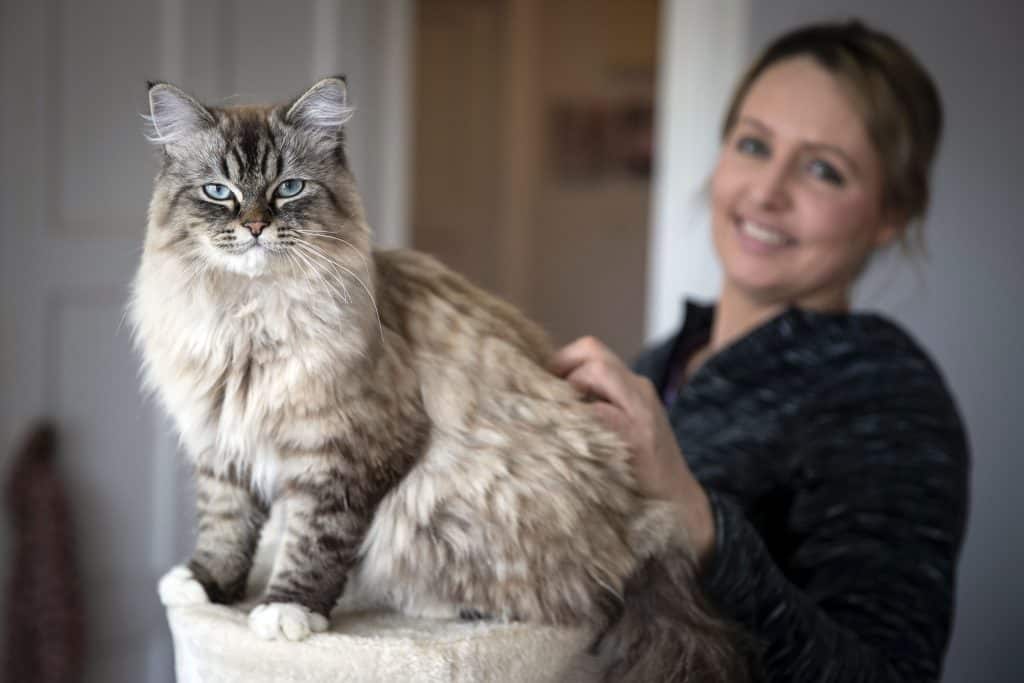
While a quite rare situation (around 1 in 10,000 specimens), cats can be hermaphrodite. This condition occurs when the chromosomes, the internal genitals, and the external genitals don’t match (23). Sometimes they may have a whole female reproductive system developed and still have a penis. Some other cases may have gonads and seminal conducts but instead of testicles and penises, they have a single hole.
While there’s not yet a known cat health problem directly related to this condition, some uncomfortable or risky situations may develop.
A good example is the case of Jessie, a cat from New Zealand who presented both sexes and had personality issues (24). But other than gender confusion, Jessie traversed other cat health problems such as passing feces and urine through the same hole.
This kind of symptoms may not be a problem as such unless the kitty has accidents around the house. But having both urine and feces going through the same tract may definitely increase the risk of FLUTD and other bacterial infections.
However, this condition may be corrected with surgery, preventing any further possible health issues both physical and mental (25).
Did you know that your pet could suffer from many cat health problems? Kittens are quite delicate creatures and finding a little help can be just what we need to be able to prevent them. If this post was helpful or you spotted a new issue on your cat’s health, let us know in the comment section so we can exchange our experience!

